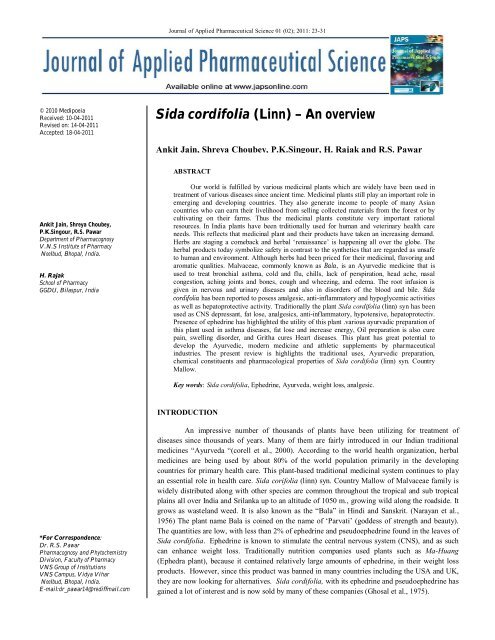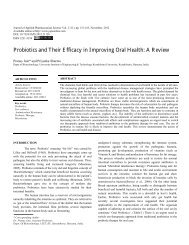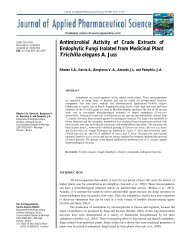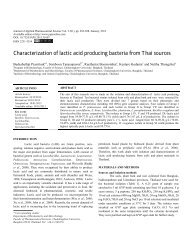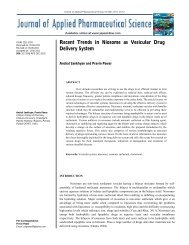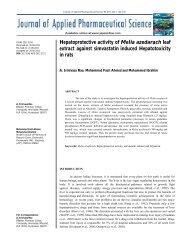Sida cordifolia (Linn) – An overview - Journal of Applied ...
Sida cordifolia (Linn) – An overview - Journal of Applied ...
Sida cordifolia (Linn) – An overview - Journal of Applied ...
You also want an ePaper? Increase the reach of your titles
YUMPU automatically turns print PDFs into web optimized ePapers that Google loves.
<strong>Journal</strong> <strong>of</strong> <strong>Applied</strong> Pharmaceutical Science 01 (02); 2011: 23-31<br />
© 2010 Medipoeia<br />
Received: 10-04-2011<br />
Revised on: 14-04-2011<br />
Accepted: 18-04-2011<br />
<strong>Sida</strong> <strong>cordifolia</strong> (<strong>Linn</strong>) <strong>–</strong> <strong>An</strong> <strong>overview</strong><br />
<strong>An</strong>kit Jain, Shreya Choubey, P.K.Singour, H. Rajak and R.S. Pawar<br />
ABSTRACT<br />
<strong>An</strong>kit Jain, Shreya Choubey,<br />
P.K.Singour, R.S. Pawar<br />
Department <strong>of</strong> Pharmacognosy<br />
V.N.S Institute <strong>of</strong> Pharmacy<br />
Neelbud, Bhopal, India.<br />
H. Rajak<br />
School <strong>of</strong> Pharmacy<br />
GGDU, Bilaspur, India<br />
Our world is fulfilled by various medicinal plants which are widely have been used in<br />
treatment <strong>of</strong> various diseases since ancient time. Medicinal plants still play an important role in<br />
emerging and developing countries. They also generate income to people <strong>of</strong> many Asian<br />
countries who can earn their livelihood from selling collected materials from the forest or by<br />
cultivating on their farms. Thus the medicinal plants constitute very important rational<br />
resources. In India plants have been trditionally used for human and veterinary health care<br />
needs. This reflects that medicinal plant and their products have taken an increasing demand.<br />
Herbs are staging a comeback and herbal ‘renaissance’ is happening all over the globe. The<br />
herbal products today symbolize safety in contrast to the synthetics that are regarded as unsafe<br />
to human and environment. Although herbs had been priced for their medicinal, flavoring and<br />
aromatic qualities. Malvaceae, commonly known as Bala, is an Ayurvedic medicine that is<br />
used to treat bronchial asthma, cold and flu, chills, lack <strong>of</strong> perspiration, head ache, nasal<br />
congestion, aching joints and bones, cough and wheezing, and edema. The root infusion is<br />
given in nervous and urinary diseases and also in disorders <strong>of</strong> the blood and bile. <strong>Sida</strong><br />
<strong>cordifolia</strong> has been reported to posess analgesic, anti-inflammatory and hypoglycemic activities<br />
as well as hepatoprotective activity. Traditionally the plant <strong>Sida</strong> <strong>cordifolia</strong> (linn) syn has been<br />
used as CNS depressant, fat lose, analgesics, anti-inflammatory, hypotensive, hepatoprotectiv.<br />
Presence <strong>of</strong> ephedrine has highlighted the utility <strong>of</strong> this plant .various ayurvadic preparation <strong>of</strong><br />
this plant used in asthma diseases, fat lose and increase energy, Oil preparation is also cure<br />
pain, swelling disorder, and Gritha cures Heart diseases. This plant has great potential to<br />
develop the Ayurvedic, modern medicine and athletic supplements by pharmaceutical<br />
industries. The present review is highlights the traditional uses, Ayurvedic preparation,<br />
chemical constituents and pharmacological properties <strong>of</strong> <strong>Sida</strong> <strong>cordifolia</strong> (linn) syn. Country<br />
Mallow.<br />
Key words: <strong>Sida</strong> <strong>cordifolia</strong>, Ephedrine, Ayurveda, weight loss, analgesic.<br />
INTRODUCTION<br />
*For Correspondence:<br />
Dr. R.S. Pawar<br />
Pharmacognosy and Phytochemistry<br />
Division, Faculty <strong>of</strong> Pharmacy<br />
VNS Group <strong>of</strong> Institutions<br />
VNS Campus, Vidya Vihar<br />
Neelbud, Bhopal, India.<br />
E-mail:dr_pawar14@rediffmail.com<br />
<strong>An</strong> impressive number <strong>of</strong> thousands <strong>of</strong> plants have been utilizing for treatment <strong>of</strong><br />
diseases since thousands <strong>of</strong> years. Many <strong>of</strong> them are fairly introduced in our Indian traditional<br />
medicines “Ayurveda “(corell et al., 2000). According to the world health organization, herbal<br />
medicines are being used by about 80% <strong>of</strong> the world population primarily in the developing<br />
countries for primary health care. This plant-based traditional medicinal system continues to play<br />
an essential role in health care. <strong>Sida</strong> corifolia (linn) syn. Country Mallow <strong>of</strong> Malvaceae family is<br />
widely distributed along with other species are common throughout the tropical and sub tropical<br />
plains all over India and Srilanka up to an altitude <strong>of</strong> 1050 m., growing wild along the roadside. It<br />
grows as wasteland weed. It is also known as the “Bala” in Hindi and Sanskrit. (Narayan et al.,<br />
1956) The plant name Bala is coined on the name <strong>of</strong> ‘Parvati’ (goddess <strong>of</strong> strength and beauty).<br />
The quantities are low, with less than 2% <strong>of</strong> ephedrine and pseudoephedrine found in the leaves <strong>of</strong><br />
<strong>Sida</strong> <strong>cordifolia</strong>. Ephedrine is known to stimulate the central nervous system (CNS), and as such<br />
can enhance weight loss. Traditionally nutrition companies used plants such as Ma-Huang<br />
(Ephedra plant), because it contained relatively large amounts <strong>of</strong> ephedrine, in their weight loss<br />
products. However, since this product was banned in many countries including the USA and UK,<br />
they are now looking for alternatives. <strong>Sida</strong> <strong>cordifolia</strong>, with its ephedrine and pseudoephedrine has<br />
gained a lot <strong>of</strong> interest and is now sold by many <strong>of</strong> these companies (Ghosal et al., 1975).
<strong>Journal</strong> <strong>of</strong> <strong>Applied</strong> Pharmaceutical Science 01 (02); 2011: 23-31<br />
<strong>Sida</strong> <strong>cordifolia</strong> is a small, erect, downy shrub. The leaves <strong>of</strong> the<br />
plant are chordate-oblong or ovate- oblong and fruits with a pair <strong>of</strong><br />
awns on each carpel. Roots <strong>of</strong> the plant which constitute a drug are<br />
5-15 cm long with few lateral roots <strong>of</strong> smaller size. The tap roots<br />
are generally branched at the tip. The outer surface <strong>of</strong> the root is<br />
<strong>of</strong>f to grayish yellow. It is almost odourless with slightly bitter<br />
taste (Rangari et al., 1995). The present review highlights the<br />
contribution <strong>of</strong> <strong>Sida</strong> <strong>cordifolia</strong> in modern system <strong>of</strong> herbal<br />
medicine for new drug development. There is correlation<br />
established between the active constituents and their uses in<br />
different diseases. Some Ayurvedic preparation and supplement <strong>of</strong><br />
plant available in market are also mention.<br />
Botanical description<br />
<strong>Sida</strong> <strong>cordifolia</strong> grows well through the plains <strong>of</strong> India,<br />
especially, in damp climates. The shrub grows up to 0.75 <strong>–</strong> 1.5<br />
meters in height. The root and the stem are stout and strong. The<br />
leaves are 2.5-7 cm long and 2.5-5 cm broad, with 7-9 veins. They<br />
are heart shaped, serrate and truncate. The flowers are small,<br />
yellow or white in colour, solitary and axillaries. The fruits are<br />
moong-sized, 6-8 mm in diameter. The seeds are called as<br />
Bijabanda in Ayurveda, are grayish black in colour and smooth.<br />
The plant flowers from August to December and fruiting occurs<br />
from October to January (Pole et al., 2006).<br />
Vernacular names<br />
‣ Hindi - Kungyi<br />
‣ English - Country mallow<br />
‣ Sanskrit - Bala<br />
‣ Tamil - Mayir-manikham<br />
‣ Bengali - Brela<br />
‣ Guajarati - Junglimethi<br />
‣ Malayalam - Velluram<br />
‣ Punjab - Simak<br />
‣ maharastra - Chikana<br />
Scientific Classification<br />
‣ Kingdom - Plantae<br />
‣ Division - <strong>An</strong>giospermae<br />
‣ Class - Eudicots<br />
‣ Order - Malvales<br />
‣ Family - Malvaceae<br />
‣ Genus - <strong>Sida</strong><br />
‣ Species - <strong>Sida</strong> <strong>cordifolia</strong><br />
Regional names: Bariar, Batyalaka, Beejband, Bijband, Brela,<br />
Chikana, Chiribenda, Chitimutti, Hettuti-gida, Janglimethi,<br />
Kharenti, Khareti, Kisangi, Kungyi, Mayir-manikham, Muttuva,<br />
Paniyar-tutti, Simak, Tupkaria, Tutturabenda and Velluram.<br />
Occurrence & Distribution<br />
Country Mallow <strong>of</strong> Malvaceae family is widely<br />
distributed along with other species are common throughout the<br />
tropical and sub tropical plains all over India and Srilanka up to an<br />
altitude <strong>of</strong> 1050 m., growing wild along the roadside.<br />
Part Used: seed, leaves, Roots<br />
Macroscopic Characters<br />
Stems - stout and strong<br />
Leaves - 2.5-7 cm long and 2.5-5 cm broad, with 7-9 veins.<br />
Flowers - small, yellow or white in colour, solitary and<br />
axillaries.<br />
Fruits - moong-sized, 6-8 mm in diameter<br />
Seeds - grayish black in colour and smooth.<br />
Chemical constituents<br />
<br />
<br />
<br />
<br />
<br />
<br />
<br />
<br />
<br />
<br />
Ephedrine.<br />
Pseudoephedrine<br />
Sterculic, malvalic and coronaric acid.<br />
Fatty acids.<br />
Saponine.<br />
Betaphenethylamine.<br />
Hypaphorine.<br />
Ecdysterone.<br />
Indole alkaloides.<br />
Palmitic, stearic and β <strong>–</strong> sitosterol.<br />
See Table 2 for chemical constituent in detail.<br />
Therapeutic Uses<br />
The Plant is alternative tonic, astringent, emollient,<br />
aphrodisiac etc.<br />
Bark - Considered as cooling. It is useful in blood, throat,<br />
urinary system related troubles, piles, phthisis, insanity<br />
etc.<br />
Seeds- The seeds as considered as aphoradisiac.<br />
Roots -It is regarded as cooling, astringment, stomachic<br />
and tonic, aromatic, bitter, diuretic.<br />
<strong>Sida</strong> <strong>cordifolia</strong> physiological effect<br />
<br />
<br />
<br />
<br />
<br />
<br />
<br />
Side effects<br />
It has a depressant rather than a stimulant effect on the<br />
Central Nervous System<br />
May decrease both blood pressure and heart rate<br />
Has a hypoglycemic (blood sugar lowering effect)<br />
No real evidence to support its use as a weight loss<br />
supplement<br />
Increases pain tolerance<br />
Has an anti-inflammatory effect<br />
Possible antioxidant effect<br />
<strong>Sida</strong> <strong>cordifolia</strong> when used excessively can cause<br />
ephedrine related side effects like insomnia, anxiety, nervousness,<br />
and increase in blood pressure, memory loss or even stroke.
<strong>Journal</strong> <strong>of</strong> <strong>Applied</strong> Pharmaceutical Science 01 (02); 2011: 23-31<br />
Ephedrine coupled with caffeine can prove fatal. Patients subjected<br />
to IOC drug testing, using MAO inhibitor medication (<strong>An</strong>tidepressants),<br />
having high blood pressure, heart disease, thyroid or<br />
prostrate condition along with pregnant or lactating women should<br />
not take this herb except under expert guidance.<br />
Traditional uses<br />
It has a long history <strong>of</strong> use by Ayurveda and rural area<br />
particularly for medicinal properties. It is in use as folk medicine in<br />
India since time immemorial. According to Ayurveda, the plant is<br />
tonic, astringent, emollient, aphrodisiac and useful in treatment <strong>of</strong><br />
respiratory system related troubles. Bark is considered as cooling.<br />
It is useful in blood, throat, urinary system related troubles, piles,<br />
phthisis, insanity etc. ( Agharkar et al., 1991).<br />
The plant is analgesic, anti-inflammatory and tonic. It<br />
affects the central nervous system and provides relief from anxiety.<br />
Its extract is consumed to reduce body weight. It tones the blood<br />
pressure and improves the cardiac irregularity. It is also useful in<br />
fever, fits, Ophthalmic, rheumatism, colic and nervous disorders. It<br />
has also been reported to improve sexual strength. <strong>Sida</strong> <strong>cordifolia</strong><br />
oils are used topically to the sore muscles and sore joints in<br />
rheumatism and arthritis with the crushed leaves can be carried out<br />
a cataplasm to alleviate local pains and because <strong>of</strong> its astringent<br />
value for the cure <strong>of</strong> external wounds or imperfections <strong>of</strong> the skin.<br />
The bronchodilator value <strong>of</strong> the vasicinone, vasicine and vasicinol<br />
are used to elaborate preparations for the treatment <strong>of</strong> the bronchial<br />
affections, especially in what refers to the cough, asthma,<br />
bronchitis, nasal congestion, flu, pain in the chest, etc. Decoction<br />
<strong>of</strong> the root <strong>of</strong> bala and ginger is given in intermittent fever attended<br />
with cold shivering fits. Root juice is also used to promote healing<br />
<strong>of</strong> wounds. Powder <strong>of</strong> the root and bark together, is given with<br />
milk and sugar for frequent micturition. Oil prepared from the<br />
decoction <strong>of</strong> root bark mixed with milk and sesame oil, finds<br />
application in diseases <strong>of</strong> the nervous system, and is very<br />
efficacious in curing facial paralysis and sciatica (koman et al.,<br />
1921). According to Ayurveda ‘Bala’ balance all the doshas <strong>–</strong> vata,<br />
pitta, kapha. It has more effect on vata dosha. Leaves are cooked<br />
and eaten in cases <strong>of</strong> bleeding piles. Juice <strong>of</strong> the whole plant,<br />
pounded with a little water is given in doses <strong>of</strong> ¼ seers for<br />
spermatorrohea, rheumatism, and gonorrhoea. Made into paste<br />
with juice <strong>of</strong> palmyra tree, it is applied locally, in elephantiasis<br />
(Yogaratnakaram).<br />
PHARMACOLOGICAL ACTIVITIES<br />
CNS depressant: Franco et al tested that rather than being a<br />
stimulant, <strong>Sida</strong> <strong>cordifolia</strong> actually acts as a depressant and<br />
decreases CNS activity. He tested the hydro alcoholic extract <strong>of</strong><br />
<strong>Sida</strong> <strong>cordifolia</strong> at a dose <strong>of</strong> 1000 mg/kg (i.p. and p.o.) produced<br />
sedation, decrease <strong>of</strong> the ambulation, reduction <strong>of</strong> answer to the<br />
touch, analgesia and decrease <strong>of</strong> urination same dose caused<br />
significant reduction (p < 0.001) <strong>of</strong> the spontaneous locomotors<br />
activity in comparison with the control group at 30 and 60 min as<br />
well as did not cause a significant difference in the motor<br />
coordination <strong>of</strong> the treated animals in comparison with the control<br />
group. He also noticed that the hydro alcoholic extract <strong>of</strong> S.<br />
<strong>cordifolia</strong> at a dose <strong>of</strong> 1000 mg/kg (i.p. or p.o.) did not produce a<br />
significant alteration <strong>of</strong> the latency and the time <strong>of</strong> sleep <strong>of</strong> the<br />
reacted animals in comparison with those from control group.<br />
(Franco et al., 2005) Medeiros et al, Additional research appears to<br />
confirm that <strong>Sida</strong> <strong>cordifolia</strong> does not stimulate the CNS (Mediros<br />
et al., 2005).<br />
Fat lose<br />
Medeiros et al studied, the oral consumption <strong>of</strong><br />
S.<strong>cordifolia</strong> by rats actually caused a decrease in both heart rate<br />
and blood pressure. If it was having a stimulatory effect we would<br />
see both heart rate and blood pressure increase. Since S.<strong>cordifolia</strong><br />
fails to increase CNS activity, as claimed by some companies, it<br />
cannot promote fat loss through CNS stimulation. (Mediros et al.,<br />
2005), However safeties <strong>of</strong> S.<strong>cordifolia</strong> extract will be always<br />
objectionable on basis <strong>of</strong>:<br />
1. Appetite suppression and cardiovascular effects as these are<br />
associated with ephedrine.<br />
2. The only support <strong>of</strong> <strong>Sida</strong> <strong>cordifolia</strong> as a weight loss product is<br />
through its hypoglycemic (blood sugar lowering) activity.<br />
Research studies have shown that it possesses a significant bloodsugar<br />
lowering activity and therefore may help to reduce the<br />
storage <strong>of</strong> fat with fat cells (Kanth et al., 1999).<br />
Today numbers <strong>of</strong> companies are promoting <strong>Sida</strong> <strong>cordifolia</strong> for<br />
anti-obesity effect. Experts are <strong>of</strong> the opinion that anti-obesity<br />
effect is not limited to ephedrine content; other constituents may<br />
play a synergistic role. Further chemical analysis reveals that<br />
seasonal variation <strong>of</strong> alkaloids in S.<strong>cordifolia</strong> less as compared to<br />
Ephedra sp. S.<strong>cordifolia</strong>, thus may be useful substitute to Ephedra<br />
sp.<br />
<strong>An</strong>algesic and anti-inflammatory<br />
Kanth and Diwan also demonstrated that S. <strong>cordifolia</strong> can<br />
increase pain tolerance and appears to have anti-inflammatory<br />
properties. (Kanth et al., 1999) When rats were exposed to heat,<br />
rats that consumed <strong>Sida</strong> <strong>cordifolia</strong> had a greater heat tolerance. It<br />
may be effective as an antioxidant (Auddy et al., 2003). Diwan<br />
and Kulkarni studied anti-inflammatory activity <strong>of</strong> ethyl acetate<br />
and alcohol extracts <strong>of</strong> S.<strong>cordifolia</strong> was studied in rats .The percent<br />
inhibition <strong>of</strong> oedema was calculated with reference to the control<br />
group. The aerial part exhibited significant anti-inflammatory<br />
activity only at a dose level <strong>of</strong> 600 mg/kg. Both <strong>Sida</strong> <strong>cordifolia</strong><br />
aerial and root extract showed dose dependent activity (Diwan et<br />
al., 1983).<br />
V Ravi Kant tested Acetic acid induced writhing test<br />
method on <strong>An</strong>algesic activities. The number <strong>of</strong> writhing episodes<br />
<strong>of</strong> eight groups <strong>of</strong> six animals were compared with those <strong>of</strong> aspirin.<br />
At a 600 mg/kg dose both S. <strong>cordifolia</strong> root and aerial extract<br />
exhibited significantly (p < 0.001) better activity than that elicited<br />
by aspirin. He also evaluated the latency time for licking <strong>of</strong> legs<br />
and jumping responses after exposure on the hot plate surface. The
<strong>Journal</strong> <strong>of</strong> <strong>Applied</strong> Pharmaceutical Science 01 (02); 2011: 23-31<br />
Table 1: Phytoconstituents <strong>of</strong> different parts <strong>of</strong> “<strong>Sida</strong> <strong>cordifolia</strong>” plant with % alkaloids<br />
Plant parts Phytoconstituents Alkaloids percents<br />
Whole parts (include leaves , Large amount <strong>of</strong> ephedrine Extend <strong>of</strong> 0.085 %<br />
stems ,seeds and roots)<br />
Seeds Sterculic, malvalic and coronaric acid along with other fatty acids. 0.32 %<br />
Leaves Ephedrine , pseudoephedrine 0.28 %<br />
Stems Ephedrine 0.22 %<br />
Roots<br />
Ephedrine, saponine, choline pseudoephedrine, betaphenethylamine,<br />
0.06 %<br />
vasicine, hypaphorine, ecdysterone and related indole alkaloides.<br />
Aerial parts Ephedrine , pseudoephedrine , Palmitic ,stearic and β <strong>–</strong> sitosterol ,<br />
hexacosanoic acids, 6-phenyl ethyl amine, carboxylated tryptomines,<br />
qunazoline, hypaphorine, vasicinol<br />
0.31 %<br />
increase <strong>of</strong> latency time in relation to the control was taken as an<br />
index <strong>of</strong> analgesic activity (Kanth et al., 1999).<br />
Hypotensive<br />
Medeiros et al performed the aqueous fraction <strong>of</strong> hydro<br />
alcoholic extract <strong>of</strong> S. <strong>cordifolia</strong> induced hypotension and<br />
bradycardia on mean arterial pressure and heart rate in nonanaesthetized<br />
rat.( Eddy et al ., 1953) Administration <strong>of</strong> atropine<br />
completely abolish the Aqueous fraction <strong>of</strong> hydro alcoholic extract<br />
<strong>of</strong> S.<strong>cordifolia</strong> induced hypotensive and bradycardic responses.<br />
Administration <strong>of</strong> hexamethonium potentiates significantly the<br />
hypotensive response and significantly attenuate bradycardic<br />
response. The administration <strong>of</strong> hexamethonium+l-NAME<br />
significantly attenuates the same extraction induced hypotensive<br />
response, but did not affect the bradycardic response (Mediros et<br />
al., 2005).<br />
Hepatoprotective<br />
Fumaric acid isolated from S.<strong>cordifolia</strong> was reported to be<br />
hepatoprotective (Kumar et al., 1997). Recent works has reported<br />
hepatoprotective effect <strong>of</strong> aqueous extract <strong>of</strong> S. <strong>cordifolia</strong> after<br />
partial hepatectomy (Silva et al., 2006).<br />
Silva investigated that <strong>Sida</strong> <strong>cordifolia</strong> stimulates insulin<br />
release by pancreatic â cells, acting like sulphonylureas. Knowing<br />
that insulin acts as an important co-mitogen it can be raised the<br />
hypothesis that the augmented release <strong>of</strong> this hormone, stimulated<br />
by <strong>Sida</strong> <strong>cordifolia</strong>, can exert a permissive role in the hepatocellular<br />
synthesis <strong>of</strong> DNA and, consequently, in liver regeneration<br />
process.(silva et al ., 2008)<br />
<strong>An</strong>ti microbial activity<br />
Mahesh et al reported that S. <strong>cordifolia</strong> leaf extract<br />
showed highest antibacterial activity against F. verticillioides .The<br />
methanol leaf extracts <strong>of</strong> tested by disc diffusion method (Mahesh<br />
et al., 2008).<br />
Adaptogenic activity<br />
Plant adaptogen are smooth prostressors which reduce the<br />
reactivity <strong>of</strong> host defense system. The mode <strong>of</strong> action <strong>of</strong><br />
adaptogens is basically associated with stress system. Adaptogen<br />
increase the capacity <strong>of</strong> stress to respond to the external signals <strong>of</strong><br />
activating and deactivating mediators <strong>of</strong> stress response<br />
subsequently. The stress induced increase in total WBC count is<br />
decreased by SCE, indicating adaptogenic activity (Sumanth<br />
Meera.et al., 2009).<br />
<strong>An</strong>ti Parkinson’s disease<br />
Parkinson’s disease Ayurveda treatment aims at balancing<br />
disturbed vata. Massage therapy, enema, medication methods are<br />
applied. In addition to Mucuna pruriens (known by names violet<br />
bean, cowhage, naikkurana and kaunch beej), Ashwaganda<br />
(Withania somnifera), <strong>Sida</strong> <strong>cordifolia</strong> are the prime herbs usable in<br />
Parkinson’s disease Ayurvedic treatment. (Dev seri et al., 2008)<br />
Wound healing activity<br />
Jaiswal studied that plant used in wound healing<br />
activity.tissue healing is an important prosses which is the basis <strong>of</strong><br />
various surgical manipulation it can be inhanced by several herbal<br />
medicine. (Jaiswal et al., 2004) Plants and their extracts have<br />
immense potential for the management <strong>of</strong> different types <strong>of</strong><br />
wounds. The phyto-medicines for wound healing are not only<br />
cheap and affordable but are also purportedly safe. However, there<br />
is a need for scientific validation, standardization and safety<br />
evaluation <strong>of</strong> plant <strong>of</strong> the traditional medicine before these could<br />
be recommended for healing <strong>of</strong> the wounds. Pharmacological<br />
screening <strong>of</strong> botanicals is necessary for viewing new chemical<br />
entities in normal subjects, which is designed to search for novel<br />
drug actions at an early stage <strong>of</strong> drug development.<br />
<strong>An</strong>ti Hypertriglyceridemic activity<br />
The antihypertriglyceridemic potential <strong>of</strong> S. rhomboidea.<br />
Roxb leaf extract mediated via decreased intestinal absorption and<br />
increased catabolism <strong>of</strong> TG. Pharmacological evidence for use <strong>of</strong><br />
sida leaf extract as a folklore medicine for controlling obesity<br />
amongst north-eastern population <strong>of</strong> Indian subcontinent.
<strong>Journal</strong> <strong>of</strong> <strong>Applied</strong> Pharmaceutical Science 01 (02); 2011: 23-31<br />
Hypoglycemic activity<br />
<strong>Sida</strong> <strong>cordifolia</strong> use as a weight loss product is through its<br />
hypoglycaemic (blood sugar lowering) activity. Research studies<br />
have shown that it possesses a significant blood-sugar lowering<br />
activity and therefore may help to reduce the storage <strong>of</strong> fat with fat<br />
cells. (Chopra et al., 1956)<br />
<strong>An</strong>ti <strong>–</strong>oxidant activity<br />
Dhalwal et al studied that all extracts <strong>of</strong> <strong>Sida</strong> <strong>cordifolia</strong>.<br />
(SC) have effective reducing power and free-radical scavenging<br />
activity. Only the root extract exhibited superoxide-scavenging<br />
activity and inhibited lipid peroxidation in rat liver homogenate.<br />
All these antioxidant properties were concentration dependent. The<br />
highest antioxidant activity was observed in the root extract.<br />
(Dhalwal et al., 1983).<br />
Other uses: The roots <strong>of</strong> S.cardifolia have been reported to<br />
possess astringent, diuretic and tonic properties. The drug has also<br />
demonstrated antibacterial, antiplaque and antifungal activities.<br />
SIDA CORDIFOLIA EPHEDRINE ACTIVITY<br />
<strong>Sida</strong> <strong>cordifolia</strong> leaves contain small quantities <strong>of</strong> both<br />
ephedrine and pseudoephidrine. However, the quantities are low,<br />
with less than 2% <strong>of</strong> ephedrine and pseudoephedrine found in the<br />
leaves <strong>of</strong> <strong>Sida</strong> <strong>cordifolia</strong>. Ephedrine is known to stimulate the<br />
central nervous system (CNS), and as such can enhance weight<br />
loss. Traditionally nutrition companies used plants such as Ma-<br />
Huang (Ephedra plant), because it contained relatively large<br />
amounts <strong>of</strong> ephedrine, in their weight loss products. Ephedrine, a<br />
2-aminophenylpropane alkaloid was first isolated from Ephedra<br />
sinica Stapf. (Ma-Huang). Ephedra gerardiana. Wall. ex Stapf is<br />
widely used in Ayurvedic system <strong>of</strong> medicine.<br />
Ephedrine is a potent bronchodilator. <strong>An</strong>other alkaloid<br />
reported form Ephedra sp is pseudoephederine which seems to be<br />
present in lower concentrations in <strong>Sida</strong> <strong>cordifolia</strong>. Ephedrine and<br />
nor ephedrine suppresses the appetite resulting in weight loss.<br />
Other alkaloids like norpseudoephedrine are less potent as<br />
compared to ephedrine and norephedrine (also known as<br />
phenylpropanolamine) and can cause serous ill effects. Therapy<br />
with nor ephedrine has been linked with stroke in young age group.<br />
Food drug administration has restricted the use <strong>of</strong> nor-ephedrine in<br />
States. Here it is not worthwhile to mention that nor is ephedrine<br />
used in common cold preparations also. (Ghosal et al., 1975)<br />
Structure <strong>of</strong> Ephedrine<br />
Ephedrine content <strong>of</strong> <strong>Sida</strong> <strong>cordifolia</strong> is less as compared<br />
to Ephedra sinica. This suggests feeble analeptic and central<br />
nervous system stimulating effects <strong>of</strong> <strong>Sida</strong> <strong>cordifolia</strong>. However<br />
<strong>Sida</strong> <strong>cordifolia</strong> contains other bronchodilator alkaloids like<br />
vasicinone, vasicine and vasicinol which are absent in Ephedra<br />
sinica. In terms <strong>of</strong> presence <strong>of</strong> alkaloids like vasicinone, vasicine<br />
and vasicinol, <strong>Sida</strong> <strong>cordifolia</strong> resembles with Adhatoda vasica<br />
Nees. N.O.: Acanthaceae. Ayurvedic formulations containing <strong>Sida</strong><br />
<strong>cordifolia</strong> should not be prescribed with cardiac glycosides,<br />
monoamine oxidase inhibitors and ergot alkaloids (Chopra et al.,<br />
1982). Although no drug interactions have been reported with <strong>Sida</strong><br />
<strong>cordifolia</strong> preparations but owing to great variation <strong>of</strong> active<br />
constituent, great care should be taken while prescribing <strong>Sida</strong><br />
<strong>cordifolia</strong> with cardiac glycosides (can cause disturbance <strong>of</strong> heart<br />
rhythm), monoamine oxidase inhibitors (as it can potentate the<br />
symapthomimetic activity) and ergot alkaloids (can cause<br />
hypertension).<br />
Although little data is available on active constituent <strong>of</strong><br />
<strong>Sida</strong> <strong>cordifolia</strong> but according to one study a minute dose <strong>of</strong> <strong>Sida</strong><br />
<strong>cordifolia</strong> given intravenously, causes a sharp and well marked rise<br />
<strong>of</strong> blood pressure in anaesthetized or decerebrated animals which is<br />
maintained for some time. This pharmacological activity <strong>of</strong> <strong>Sida</strong><br />
<strong>cordifolia</strong> resembles with ephedrine. According to Mark<br />
Blumenthal effects <strong>of</strong> ephedrine should not be confused with<br />
Ephedra sinica. This is a typical example <strong>of</strong> difference in<br />
pharmacological activities <strong>of</strong> whole herb and isolated constituents.<br />
Similar concept applies when we compare <strong>Sida</strong> <strong>cordifolia</strong> with<br />
ephedrine. (Singh et al., 2006)<br />
AYURVEDIC PREPARATIONS<br />
In Ayurvedic texts, bala is from a group <strong>of</strong> four herbs<br />
alacatustay. Maharsi Caraka has categorized bala as brmhaniya , a<br />
bulk promoting herb and as balya tonic and prajasthapana which<br />
promotes reproduction. Acarya Vagbhata and Susruta have cited it<br />
as vata samsamana pacifies the vata dosa., Caraka has also<br />
mentioned it as a rejuvenative (rasayana) to muscle tissue (mamsa<br />
dhatu) and muscular system (mamsavaha srotasa) ( Caraka<br />
Samhita)<br />
Externally used preparation<br />
Externall, the medicated oil <strong>of</strong> bala, Bala siddha taila, is<br />
massaged to alleviate pain and swelling in vata disorders. The<br />
paste <strong>of</strong> its leaves is applied in ophthalmic diseases and for wound<br />
dressing. In children, the famous oil preparation <strong>of</strong> bala <strong>–</strong> Candan<br />
bala laksadi taila is used for massage in muscular weakness.<br />
Internally used preparation<br />
Internally, bala is the best nervine tonic and rasayana for<br />
all kinds <strong>of</strong> vata disorders. It is also rejuvenative, nutritive and<br />
stimulant to the heart. As a milk decoction with sugar, it is a good<br />
nutritive and aphrodisiac. It also promites healing <strong>of</strong> tissue in<br />
chronic infectious diseases. In particular, it is highly recommended<br />
in extensive tuberculosis with cavitation. For that the decoction <strong>of</strong><br />
its roots works well, when given with ghee and honey. It promotes<br />
the heling <strong>of</strong> lung tissue and curbs the cavitation. Bala is a valuable<br />
blood purifier helpful in raktapitta and piles. It is especially<br />
anabolic to muscle tissue and augments the seminal fluids, and<br />
promotes reproduction. As it helps building the muscle tissue, it<br />
boosts the strength and hence, imparts a rejuvenative action. As a<br />
tonic, it is commonly used in general debility. In menorrhagia it is<br />
salutary as it is styptic as well as blood purifier. It also boosts the<br />
foetal growth. Bala mula siddha dugdha- the medicated milk <strong>of</strong>
<strong>Journal</strong> <strong>of</strong> <strong>Applied</strong> Pharmaceutical Science 01 (02); 2011: 23-31<br />
Table 2:- List <strong>of</strong> Chemical Constituents<br />
S.N Chemical constituents Inference References<br />
1. Tannins Absent Koman.et al., 1921<br />
2. Mucins Present Koman.et al., 1921<br />
3. potassium nitrate Present Koman.et al., 1921<br />
4. Resins Present Koman.et al., 1921<br />
5. resins acid Present Koman.et al., 1921<br />
6. Proteins<br />
7. Carbohydrate<br />
8. Fiber<br />
Present (74,000ppm to<br />
347,000ppm)<br />
Present<br />
(94,000ppm to 475,000ppm)<br />
Present<br />
33,000ppm to 167,000ppm<br />
Available on www.fao.org<br />
Available on www.fao.org<br />
Available on www.fao.org<br />
9. Fat Present<br />
Rangari VD et al., 1999<br />
14,000ppm to 71,000ppm<br />
Flavones<br />
Present Ranajit K et al., 1982<br />
10 (5, 7-dihydroxy-3-isoprenyl flavones,<br />
5-hydroxy-3-isoprenyl flavones)<br />
Essential oils Present Ghosal et al., 1975<br />
12<br />
13<br />
Alkaloids: ephedrine, pseudoephedrine, vasicinone,<br />
vasicine and vasicinol<br />
Present Ghosal et al., 1975<br />
bala heals the ulcers and wounds <strong>of</strong> urinary tract, alleviate bleeding<br />
in urine and relieves dysuria. In vata disorders like paralysis, facial<br />
palsy, cervical spondylosis etc. Bala works well as a nervine tonic.<br />
N such conditions, the decoction <strong>of</strong> its roots given orally and bala<br />
siddha taila <strong>–</strong> its mediacted oil is used for massage. Bala oil can be<br />
used orally, externally for massage and for giving enema (basti)<br />
also. The fresh juice <strong>of</strong> whole plant is recommended for raktapitta<br />
bleeding disorders, along with the milk and rock candy<br />
(ayurvedic.com).<br />
Classical Ayurvedic Preparations<br />
Bala taila<br />
Satapakiksirabala<br />
Bala curna / swarasa<br />
Baladya ghrta<br />
Baladyarista<br />
Baladi kvatha<br />
Candana balalaksadi taila<br />
Externall, the medicated oil <strong>of</strong> bala, Bala siddha taila, is<br />
massaged to alleviate pain and swelling in vata disorders. In<br />
children, the famous oil preparation <strong>of</strong> bala, Candan bala laksadi<br />
taila is used for massage in muscular weakness. Bala mula siddha<br />
dugdha- the medicated milk <strong>of</strong> bala heals the ulcers and wounds <strong>of</strong><br />
urinary tract, alleviate bleeding in urine and relieves dysuria<br />
(www.herbcureindia.com). The popular Mahanarayana taila, Balati<br />
taila, Prabhanjana Vimardhana, Ksheera-bala taila contain this<br />
herb. The oils are used topically to massage the sore muscles, sore<br />
joints in arthritis and rheumatism, in sciatica and neuritis <strong>of</strong> legs.<br />
<strong>An</strong>other oil called Dhanvantari tailam (21 and 101 times boiled)<br />
which contains Bala along with 47 other substances, Baladhyam<br />
Gritham, Yakshmani. This gritha is given for the following<br />
diseases: fever, T.B, bronchitis, headache, and migraine.<br />
Chakrapani Datta recommended that this gritha can be consumed<br />
by adding two parts <strong>of</strong> milk to it (Koman et al 1921).<br />
Baladhyam Gritham, Urakshathe<br />
This Gritha cures Heart diseases, colic, bronchitis and<br />
vata-pitta doshas. Ayurvedic formulations containing <strong>Sida</strong><br />
<strong>cordifolia</strong> should not be prescribed with cardiac glycosides,<br />
monoamine oxidase inhibitors (Dawson et al., 1995).<br />
Supplements <strong>of</strong> S. <strong>cordifolia</strong>: These are the strongest <strong>Sida</strong><br />
<strong>cordifolia</strong> health supplement currently on the market:-<br />
1) <strong>Sida</strong> Cordifolia 400 mg <strong>of</strong> a 4:1 Extract (1600 mg) 60<br />
Capsules-1-2 capsules per day can help you to take advantage <strong>of</strong><br />
the many health benefits provided by the <strong>Sida</strong> Cordifolia herb:-<br />
- may enable super-charged workout<br />
- may help fat burning and weight.<br />
-may increase energy, concentration and focus.<br />
- may provide respiratory relief from asthma and bronchitis.<br />
- may provide Joint pain anti-inflammatory relief.<br />
2) Garnell sida <strong>cordifolia</strong> <strong>–</strong> 90 vegicaps<br />
3) Cnp sida <strong>cordifolia</strong> 120 tablets<br />
4) Reflex <strong>Sida</strong> <strong>cordifolia</strong> complex<br />
<strong>Sida</strong> <strong>cordifolia</strong> complex is a herbal complex designed to<br />
trigger fast fat loss. It contains precise ratio <strong>of</strong> sida <strong>cordifolia</strong> (10%<br />
alkaloids) Gurana (22% caffeine) and white willow bark (20%<br />
salicin) to trigger thermogenesis (fat loss).<br />
5) <strong>Sida</strong> <strong>cordifolia</strong> slimming pills.<br />
6) Chocolate banana sida <strong>cordifolia</strong> 1600mg.<br />
7) <strong>Sida</strong> Cordifolia 120 Tablets CNP Nutritional Supplements.
<strong>Journal</strong> <strong>of</strong> <strong>Applied</strong> Pharmaceutical Science 01 (02); 2011: 23-31<br />
Fig. 1:- 5, 7-dihydroxy-3-isoprenyl flavones. Fig. 2:- 5-hydroxy-3-isoprenyl flavones. Fig. 3:- Structure <strong>of</strong> Ecdysterone.<br />
Fig. 4:- Structure <strong>of</strong> hypaphorine<br />
Fig 5:- Structure <strong>of</strong> ephedrine<br />
8) Evolution sida <strong>cordifolia</strong> (400 mg capsules)<br />
9) Hydroslim effervescent slimming tablets (tablets)<br />
Marketed preparation:<br />
Fig 6:- Ephedrine Derivatives<br />
However it is too early to say about benefit <strong>of</strong> the plant in<br />
treating obesity as negligible data has accumulated in term <strong>of</strong> its<br />
efficacy. Further the plant has hypoglycemic and appetite<br />
suppressant activity. <strong>An</strong>imal experiments however report<br />
hepatoprotectiv effect <strong>of</strong> S.<strong>cordifolia</strong>.<br />
‣ Baladhyam Gritham <strong>–</strong><br />
Yakshmani Bala swadhamstra brihati kalasi dhavani sthira.<br />
Nimbhaha parpatakam mustham trayamanam dhuralaba.<br />
Krithva kashayam peshyardham dhadya dhamalakim satim.<br />
Dhrksha pushkaramulastcha medha mamalakanicha.<br />
Gritham payascha tharsidham sarpi jawaraharam param.<br />
Kshaya kasa prasamanam sirah parswa rujapaham.<br />
‣ According to Ayurveda ‘Bala’ balances all the doshas <strong>–</strong> vata,<br />
pitta, kapha. It has more effect on vata dosha.<br />
Valatitikta madhura pittatisaranasani<br />
Valaviryaprada pustikapharogavisodhani<br />
Typical preparations and dosage <strong>of</strong> bala / sida cordifloia<br />
Suggested Dosage:<br />
1.Bala fair trade Powder <strong>–</strong>Take 1/2 to 2 grams per day, use<br />
mixed with milk or fruit juice. (Can be split up over day)<br />
2.Bala / <strong>Sida</strong> <strong>cordifolia</strong> Fair trade Tincture <strong>–</strong> Extraction Ratio 1:3<br />
Alcohol vol. 25% 5-10ml daily (can be split up into 2-3 doses per<br />
day) or as directed by an herbal practitioner.<br />
CONCLUSION<br />
S.<strong>cordifolia</strong> is widely used for its medicinal applications.<br />
Presence <strong>of</strong> ephedrine has highlighted the utility <strong>of</strong> the plant.<br />
REFERENCES<br />
Agharkar S P. medicinal plants <strong>of</strong> Bombay<br />
presidenc.Pbl.scientific publishers.Jodhpur.India 1991; 194-195.<br />
<strong>An</strong>nonyms. Compendium <strong>of</strong> Indian medicinal plants. :Vol<br />
4. 1985 <strong>–</strong> 1989; 674-676.<br />
<strong>An</strong>nonyms. The Indian materia medica: With Ayurvedic,<br />
Unani and Home remedies. vol III ;1134-37<br />
Auddy B, Ferreira M, Blasina F, Lafon L, Arredondo<br />
F, Dajas F, Tripathi PC, Seal T, Mukherjee B. Screening <strong>of</strong><br />
antioxidant activity <strong>of</strong> three Indian medicinal plants, traditionally<br />
used for management <strong>of</strong> neurodegenerative diseases. J Ethno<br />
pharmacol. 84.2003; 131-38.<br />
Available on www.amazon.co.uk.<br />
Available on www.evoution<strong>–</strong>slimming.com.<br />
Available on www.fao.org.<br />
Available on www.herbcureindia.com.<br />
Available on www.troohealthcare.com.<br />
Available on www.wikio.co.uk.<br />
Available on, http://informahealthcare<br />
Bhandari MM. Flora <strong>of</strong> Indian desert. Pbl. MPS Repros.<br />
Jodhpur. India; 1990.66-69<br />
Chopra Kanth VR, Diwan PV. <strong>An</strong>algesic, antiinflammatory<br />
and hypoglycemic activities <strong>of</strong> <strong>Sida</strong> <strong>cordifolia</strong>.<br />
Phytotherapy research. PTR 13 (1) 1999; 75<strong>–</strong>77.<br />
Chopra, R.NIndigenous Drugs <strong>of</strong> India, Academic<br />
Publishers, Calcutta, (1982).
<strong>Journal</strong> <strong>of</strong> <strong>Applied</strong> Pharmaceutical Science 01 (02); 2011: 23-31<br />
Cordell GA. Biodiversity and drug discovery: a symbiotic<br />
relationship, Photochemistry. 2000; 56: 463-480.<br />
Dawson JK, Eamshaw SM, Graham CS. Dangerous<br />
monoamine oxidase inhibitor interactions are still occurring in the<br />
1990s. J Accid Emerg Med. 1995; 49-51.<br />
Dawson, J.K.; Eamshaw, S.M.; Graham, C.S. Dangerous<br />
monoamine oxidase inhibitor interactions are still occurring in the<br />
1990s. J Accid Emerg Med. (1995),12(1): 49-51.<br />
Diwan PV, Kulkarni DR. <strong>An</strong>ti-inammatory activity <strong>of</strong><br />
nandrolone phenylpropionate. Indian J. Exp. Biol. 21.1983; 569-<br />
573.<br />
Eddy N B, Leimbach D J. Synthetic analgesics. II.<br />
Dithienylbutenyl and dithienylbutilamines. J. Pharmacol. Exp.<br />
Ther.1953; 385<br />
Eric Wooltorton, Ephedra/ephedrine: cardiovascular and<br />
CNS effects CMAJ , 2002; 166 -176.<br />
Franco CIF, Morais LCSL, Quintans-Junior LJ, Almeida<br />
RN, <strong>An</strong>toniolli AR. CNS pharmacological effects <strong>of</strong> the<br />
hydroalcoholic extract <strong>of</strong> <strong>Sida</strong> <strong>cordifolia</strong> L. leaves. J ethano. 2005;<br />
98. 275-79.<br />
Franzotti EM, Santos CV, Rodrigues HM, Mourão RH,<br />
<strong>An</strong>drade MR, <strong>An</strong>toniolli AR .anti-inflammatory, analgesic activity<br />
and acute toxicity <strong>of</strong> sida <strong>cordifolia</strong> l. (malva-branca). J ethno<br />
pharmacol 72 (1-2) 2000; 273<strong>–</strong>78.<br />
Ghosal S, Chauhan RRPS, Mehta R. Alkaloids <strong>of</strong> <strong>Sida</strong><br />
<strong>cordifolia</strong>. Phyto Chem. 1975; 14. 830-32.<br />
Ghosal, S.; Chauhan, R.R.P.S. and Mehta, R. (1975).<br />
Alkaloids <strong>of</strong> <strong>Sida</strong> <strong>cordifolia</strong>. Phytother Res. 14: 830-2.<br />
Haller CA, Benowitz NL. Adverse cardiovascular and<br />
central nervous system events associated with dietary supplements<br />
containing Ephedra alkaloids. NJEM. 2000; 34(3):1833-38.<br />
Jenny M, Schwaiger W, Bernhard D, Wrulich OA,<br />
Cosaceanu D, Fuchs D, Ueberall F. Apoptosis induced by the<br />
Tibetan herbal remedy PADMA 28 in the T cell-derived<br />
lymphocytic leukemia cell line CEM-C7H2. J Crsino 4 .2005; 15.<br />
Koman. Indian Materia Medica Gazette. Aug; 1921.<br />
Kumar RS, Mishra SH. <strong>An</strong>ti-inflammatory and<br />
hepatoprotective activities <strong>of</strong> <strong>Sida</strong> <strong>cordifolia</strong> <strong>Linn</strong>. Ind J<br />
Pharmacol .1997; 110-16.<br />
Mediros IA, Santos MRV, Nascimento NMS, Duarte JC.<br />
Cardiovascular effects <strong>of</strong> <strong>Sida</strong> <strong>cordifolia</strong> leave extract in rats.<br />
Fitoterapia.2005.<br />
Nayar and Chopra. Glossary Indian med: plants, PID.<br />
New Delhi; 1956.227.<br />
Pole, Sebastian.Ayurvedic medicine. Elsevier Health<br />
Sciences. 2006; 137.<br />
Ranajit K. Sutradhar AKM, Matior R, Mesbah UA, Sitesh<br />
CB. Phyto chem. letters, vol 1, issue 4.2008;179-82<br />
Rangari VD.Pharmacognosy and Phytochemistry. Part II;<br />
first edition; (2000) 274-275.<br />
Seigmund E, Cadmus R, Lu GA. method for evaluation <strong>of</strong><br />
non- narcotic and narcotic analgesics. Proc. Soc. Exp. Biol. Med.<br />
95.1957; 729.<br />
Silva RL, Melo GB, Melo VA, <strong>An</strong>toniolli AR, Michellone<br />
PR, Zucoloto S, Picinato MA, Franco CF et al. Effect <strong>of</strong> the<br />
aqueous extract <strong>of</strong> <strong>Sida</strong> <strong>cordifolia</strong> on liver regeneration after partial<br />
hepatectomy. Acta cirurgica brasileira / Sociedade Brasileira para<br />
Desenvolvimento Pesquisa em Cirurgia 21 Suppl 1 2006; 37<strong>–</strong>9.<br />
Silva RS et al. Effect <strong>of</strong> the aqueous extract <strong>of</strong> <strong>Sida</strong><br />
<strong>cordifolia</strong> on liver regeneration after partial hepatectomy. Acta Cir.<br />
21(1) .2006; 77-79.<br />
Sumanth Meera and Mustafa S. S., <strong>An</strong>tistress and<br />
Adoptogenic Activity <strong>of</strong> <strong>Sida</strong> <strong>cordifolia</strong> Roots in Mice, Ind J<br />
Pharm Sci. 2009 May<strong>–</strong>Jun; 71(3): 323<strong>–</strong>324<br />
WHO monograph on selected medicinal plants. Vol. I and<br />
II; 1996, 97.<br />
Yogaratnakaram.madhyama kandam; 346-347.<br />
Yogaratnakaram.madhyama khandam;316-17.


